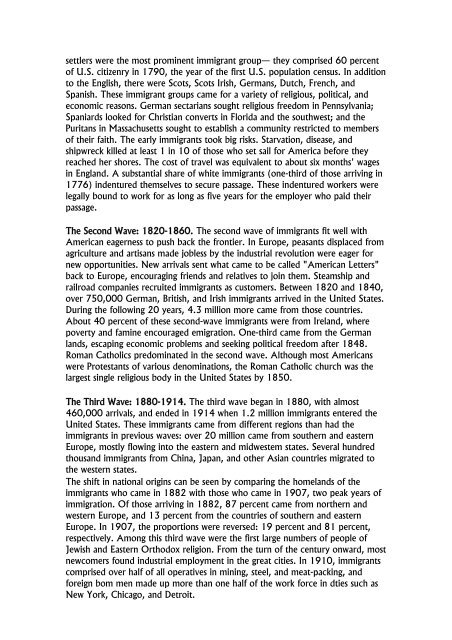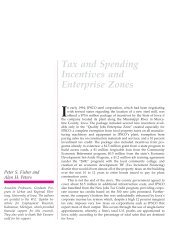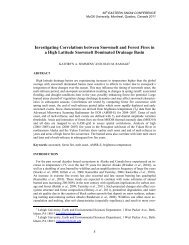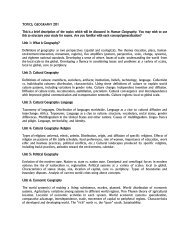PEOPLE ON THE MOVE - Department of Geography
PEOPLE ON THE MOVE - Department of Geography
PEOPLE ON THE MOVE - Department of Geography
You also want an ePaper? Increase the reach of your titles
YUMPU automatically turns print PDFs into web optimized ePapers that Google loves.
settlers were the most prominent immigrant group— they comprised 60 percent<br />
<strong>of</strong> U.S. citizenry in 1790, the year <strong>of</strong> the first U.S. population census. In addition<br />
to the English, there were Scots, Scots Irish, Germans, Dutch, French, and<br />
Spanish. These immigrant groups came for a variety <strong>of</strong> religious, political, and<br />
economic reasons. German sectarians sought religious freedom in Pennsylvania;<br />
Spaniards looked for Christian converts in Florida and the southwest; and the<br />
Puritans in Massachusetts sought to establish a community restricted to members<br />
<strong>of</strong> their faith. The early immigrants took big risks. Starvation, disease, and<br />
shipwreck killed at least 1 in 10 <strong>of</strong> those who set sail for America before they<br />
reached her shores. The cost <strong>of</strong> travel was equivalent to about six months' wages<br />
in England. A substantial share <strong>of</strong> white immigrants (one-third <strong>of</strong> those arriving in<br />
1776) indentured themselves to secure passage. These indentured workers were<br />
legally bound to work for as long as five years for the employer who paid their<br />
passage.<br />
The Second Wave: 1820-1860. The second wave <strong>of</strong> immigrants fit well with<br />
American eagerness to push back the frontier. In Europe, peasants displaced from<br />
agriculture and artisans made jobless by the industrial revolution were eager for<br />
new opportunities. New arrivals sent what came to be called "American Letters"<br />
back to Europe, encouraging friends and relatives to join them. Steamship and<br />
railroad companies recruited immigrants as customers. Between 1820 and 1840,<br />
over 750,000 German, British, and Irish immigrants arrived in the United States.<br />
During the following 20 years, 4.3 million more came from those countries.<br />
About 40 percent <strong>of</strong> these second-wave immigrants were from Ireland, where<br />
poverty and famine encouraged emigration. One-third came from the German<br />
lands, escaping economic problems and seeking political freedom after 1848.<br />
Roman Catholics predominated in the second wave. Although most Americans<br />
were Protestants <strong>of</strong> various denominations, the Roman Catholic church was the<br />
largest single religious body in the United States by 1850.<br />
The Third Wave: 1880-1914. The third wave began in 1880, with almost<br />
460,000 arrivals, and ended in 1914 when 1.2 million immigrants entered the<br />
United States. These immigrants came from different regions than had the<br />
immigrants in previous waves: over 20 million came from southern and eastern<br />
Europe, mostly flowing into the eastern and midwestem states. Several hundred<br />
thousand immigrants from China, Japan, and other Asian countries migrated to<br />
the western states.<br />
The shift in national origins can be seen by comparing the homelands <strong>of</strong> the<br />
immigrants who came in 1882 with those who came in 1907, two peak years <strong>of</strong><br />
immigration. Of those arriving in 1882, 87 percent came from northern and<br />
western Europe, and 13 percent from the countries <strong>of</strong> southern and eastern<br />
Europe. In 1907, the proportions were reversed: 19 percent and 81 percent,<br />
respectively. Among this third wave were the first large numbers <strong>of</strong> people <strong>of</strong><br />
Jewish and Eastern Orthodox religion. From the turn <strong>of</strong> the century onward, most<br />
newcomers found industrial employment in the great cities. In 1910, immigrants<br />
comprised over half <strong>of</strong> all operatives in mining, steel, and meat-packing, and<br />
foreign bom men made up more than one half <strong>of</strong> the work force in dties such as<br />
New York, Chicago, and Detroit.
















